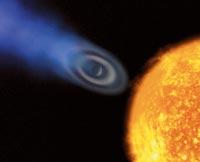Exoplanets in sight, in the end!

Thanks to the NASA Spitzer Space Telescope, two teams of astrophysicists have seen an exopl-net thanks to the infrared light they emit. A team from the Goddard center has seen the exoplanet HD 209458b and another team from the Harvard-Smithsonian TrES-1 center.
Both orbit very close to a star, so they have very high temperatures and move quickly. And thanks to this they have seen them, because the groups had short observation times.
In principle, the goal is to see cooler planets, such as Earth, but it will cost much more: being further away from the star, they orbit slower and observations to detect them will take a long time to arrive.
However, 130 exoplanets have already been detected (known for their influence on the movement of the orbiting star). And in the end it has been a great progression to see two of them. In addition, there was much competition to be the first to achieve it.





